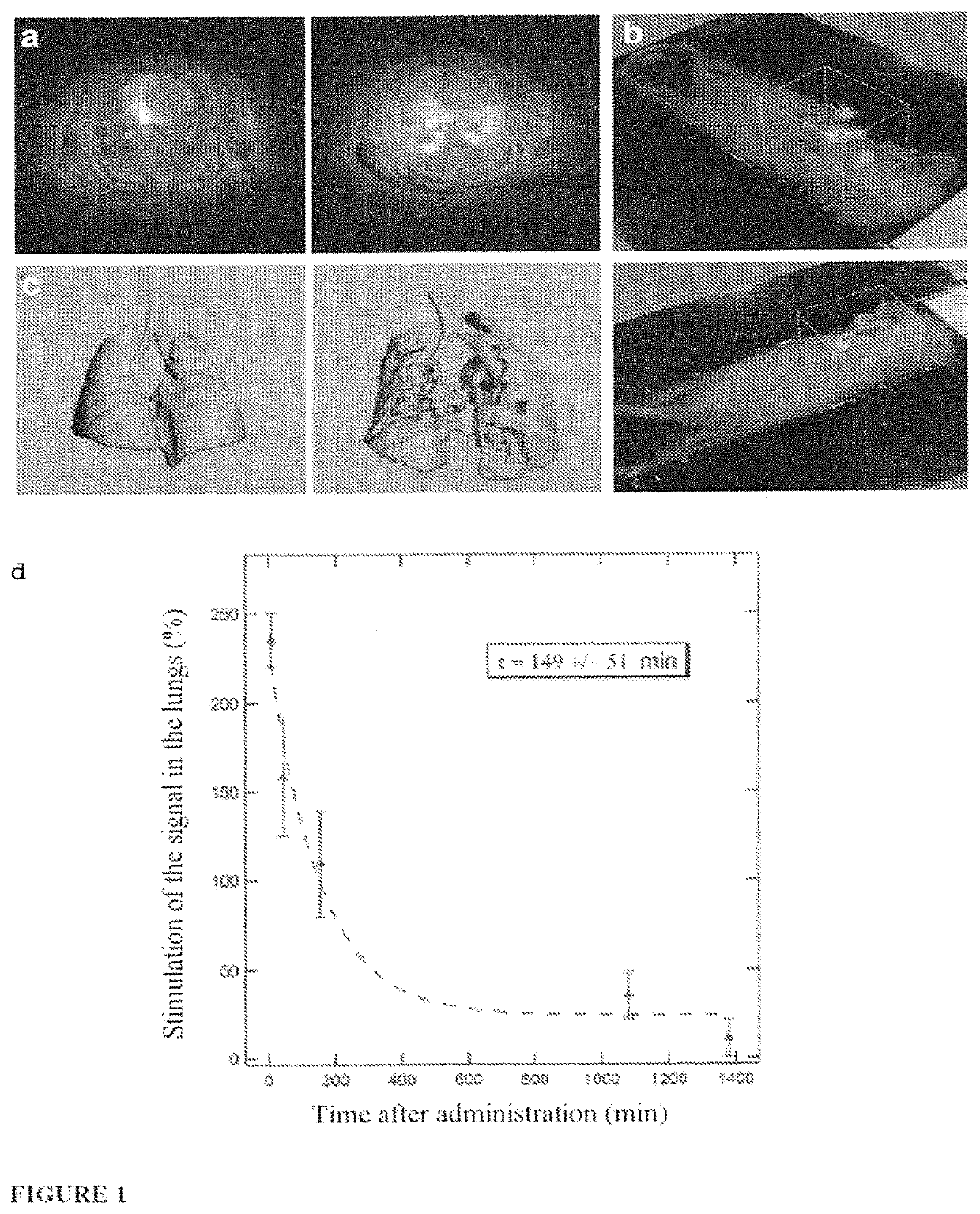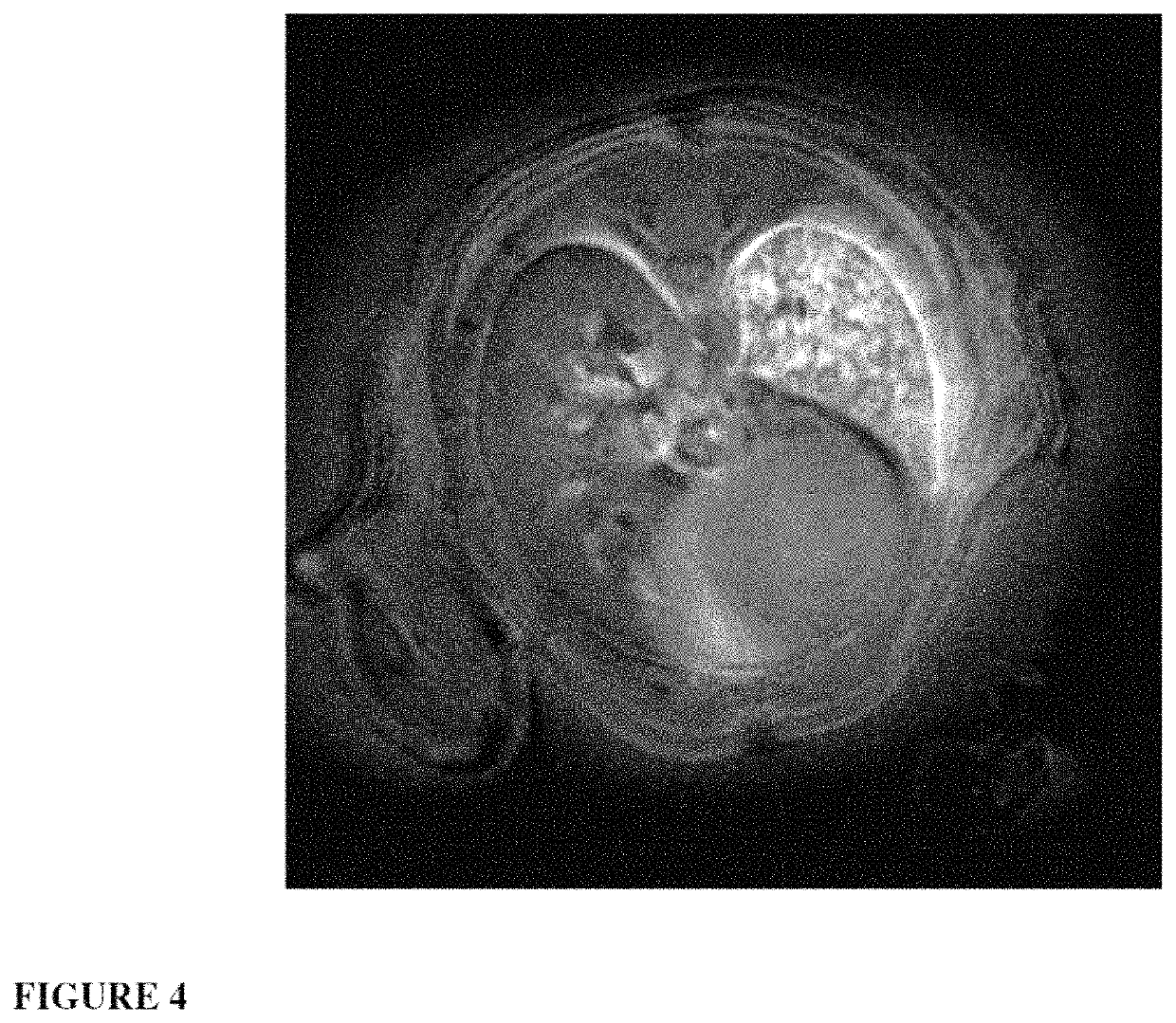Ultrafine nanoparticles as multimodal contrast agent
a technology of nanoparticles and contrast agents, applied in the direction of capsule delivery, microcapsules, drug compositions, etc., can solve the problems of low survival rate of patients suffering from lung cancer, inability to optimally use negative contrast agents for imaging the lung, and inability to meet the needs of patients with lung cancer
- Summary
- Abstract
- Description
- Claims
- Application Information
AI Technical Summary
Benefits of technology
Problems solved by technology
Method used
Image
Examples
example 1
Synthesis of Hybrid Gadolinium Nanoparticles of Gd—Si-DOTA: SRP (Small Rigid Platforms) Type
[0200]The nanoparticles are obtained by means of a three-stage synthesis as described in WO 2011 / 135101. First of all, the oxide cores are synthesized in diethylene glycol before growth of the polysiloxane layer, followed by the covalent grafting of completing agents to the surface of the nanoparticle; the gadolinium oxide core dissolves when placed in water, thereby leading to fragmentation of the particles which makes it possible to obtain small particles of less than 5 nanometers composed only of polysiloxane, or organic species and of complexing agents useful in imaging.
[0201]The advantage of this top down approach is to make it possible to obtain very small particles which have multimodal characteristics while at the same time having the advantage of being easy to eliminate via the kidneys.
Detailed Description of the Synthesis
Oxide Cores
[0202]A first solution is prepared by dissolving 5....
example 2
Functionalization of the Nanoparticles for Active Targeting of Tumors: SRP-cRGD
[0206]The nanoparticles used for the grafting are similar to those described in example 1. They therefore possess a set of free DOTAs (and thus of available carboxylic acid functions) for the grafting of cRGD which is known to be an agent that targets αvβ3 integrin. The grafting of cRGD to the particle is carried out by means of peptide coupling between a carboxylic acid function of a DOTA unit and the primary amine function of the cRGD peptide. The nanoparticles obtained in example 1 are diluted in water (Gd3+ concentration of around 100 mM). A mixture of EDC and NHS (3.4 EDC and 3.4 NHS per Gd) is added to the particles, the pH is adjusted to 5 and the mixture is kept stirring for 30 minutes. The cRGD (2.3 cRGD per Gd) is dissolved separately in anhydrous DMSO. It is then added to the previous solution and the pH of the mixture is adjusted to 7.1 before leaving it to stir for 8 hours. The solution is fi...
example 3
Analysis of the Interaction of SRPcRGD Nanoparticles Obtained According to Example 2 with Cells Expressing αvβ3 Integrin by Flow Cytometry and Fluorescence Microscopy
Analysis by Fluorescence Microscopy
[0207]HEK293(β3) cells, which overexpress αvβ3 integrin, are cultured on coverslips in 12-well plates (100 000 cells per well) overnight at 37° C. They are rinsed once with 1×PBS, then with 1×PBS containing 1 mM of CaCl2 and 1 mM of MgCl2. They are then incubated for 30 minutes at 4° C. (binding analysis) or 30 minutes at 37° C. (internalization analysis), in the presence of SRP (nanoparticles according to example 1) with a fluorophore of Cy5.5 type, of SRP-cRGD (obtained according to example 2) Cy5.5 or of SRP-cRAD (obtained according to example 2 and acting as a negative control) Cy5.5 at a Gd3+ ion concentration of 0.1 mM. They are then rinsed with PBS Ca2+ / Mg2+ (1 mM) and fixed (10 minutes with 0.5% paraformaldehyde. The nuclei are labeled with Hoechst 33342 (5 μM for 10 minutes) (...
PUM
| Property | Measurement | Unit |
|---|---|---|
| mean diameter | aaaaa | aaaaa |
| mean diameter | aaaaa | aaaaa |
| diameter | aaaaa | aaaaa |
Abstract
Description
Claims
Application Information
 Login to View More
Login to View More - R&D
- Intellectual Property
- Life Sciences
- Materials
- Tech Scout
- Unparalleled Data Quality
- Higher Quality Content
- 60% Fewer Hallucinations
Browse by: Latest US Patents, China's latest patents, Technical Efficacy Thesaurus, Application Domain, Technology Topic, Popular Technical Reports.
© 2025 PatSnap. All rights reserved.Legal|Privacy policy|Modern Slavery Act Transparency Statement|Sitemap|About US| Contact US: help@patsnap.com



